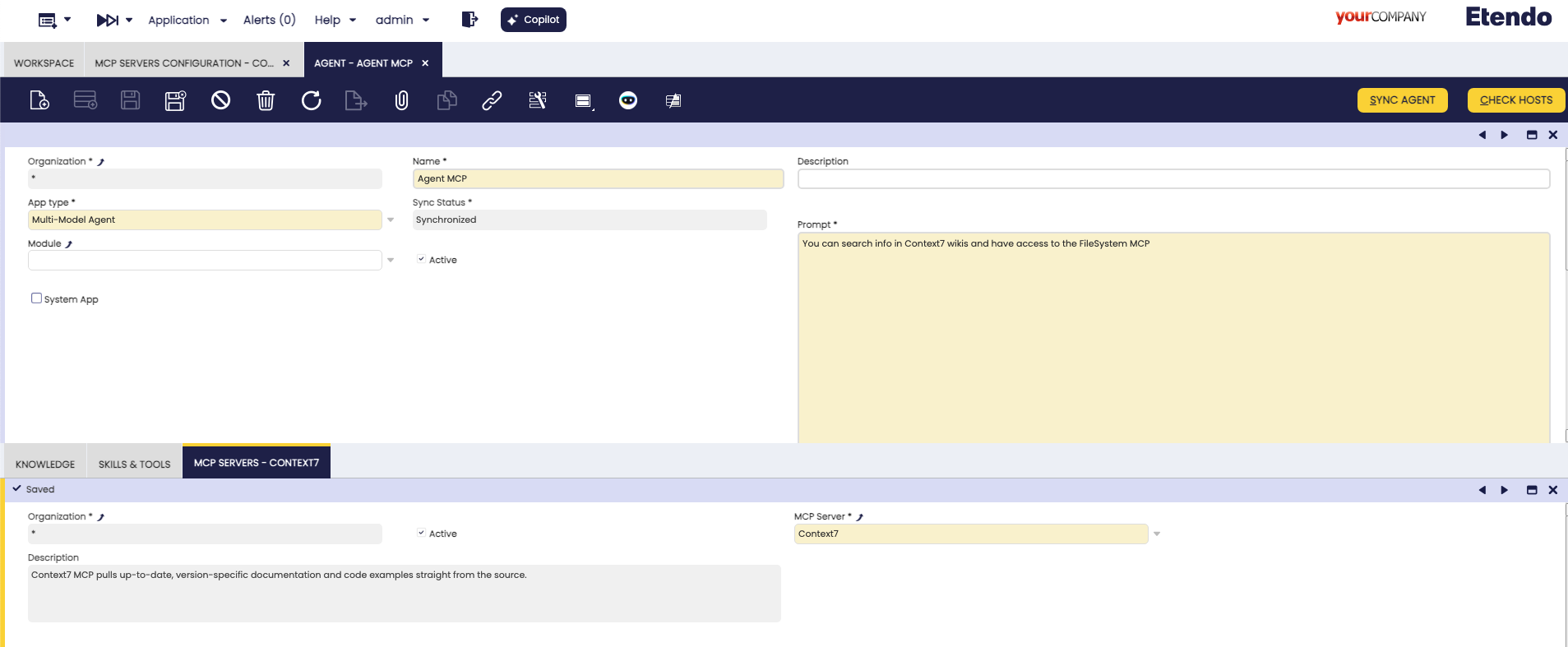How to configure MCP servers on Etendo Agents
Overview
IMPORTANT: THIS IS A BETA VERSION
It is under active development and may contain unstable or incomplete features. Use it at your own risk. The module behavior may change without notice. Do not use it in production environments.
This guide provides step-by-step instructions to help you create and configure Model Context Protocol (MCP) Servers for Etendo Copilot.
MCP Servers extend agent functionality by providing external tools and resources that can be dynamically loaded and used during agent interactions.
What is Model Context Protocol?
MCP is an open-source protocol that enables seamless integration between Large Language Models (LLMs) and external tools, data sources, and services. More information can be found in the Model Context Protocol (MCP) concept page.
Step-by-Step Guide
Create MCP Server Configuration
Application > Service > Copilot > MCP Servers Configuration
- Open the MCP Servers Configuration window (System Administrator role)
-
Create a new record with the following information:
- Name: A descriptive name for your MCP server.
- Description: A brief description of what the MCP server provides.
- JSON Structure: The configuration JSON for the MCP server.
Configure JSON Structure
The JSON Structure field contains the MCP server configuration. You can paste MCP configurations exactly as they appear in documentation and websites, including full configurations with wrapping keys.
Repository of Available MCP Servers
A curated list of MCP servers can be found in the official Model Context Protocol Servers repository, which aggregates many available servers.
Examples:
Simple server configuration:
{
"command": "npx",
"args": ["@modelcontextprotocol/server-filesystem", "/tmp/mcp-test"],
"transport": "stdio"
}
Full MCP configuration (as found in most documentation):
{
"mcp": {
"servers": {
"context7": {
"command": "npx",
"args": ["-y", "@upstash/context7-mcp"]
}
}
}
}
The system automatically normalizes different JSON structures and transport types. If transport is omitted and command is present, it defaults to stdio.
Docker MCP Servers Not Supported
MCP servers that use Docker are currently not supported. Currently, only MCP Servers that use NPX, HTTP, SSE,UV or UVX work in Etendo since it's a beta functionality.
Important
- The system automatically validates and normalizes the
JSONstructure when you save the MCP configuration. - If the
JSONis invalid, you will receive an error message and the record will not be saved until corrected. - When multiple servers are defined in a single configuration, each server will be treated as a separate MCP configuration.
- The server name from nested structures will be combined with the MCP record name (e.g., "MyMCP::filesystem").
Link MCP Server to Agent
Application > Service > Copilot > Agent
- Open the Agent window in Etendo.
- Select an existing agent or create a new one.
-
Navigate to the MCP tab within the Agent window and Create a new record.
MCP Server: Select the MCP server just created.
Test MCP Integration
-
Start a conversation with your configured agent
-
Request actions that would utilize MCP tools:
-
Observe agent behavior:
- The agent will automatically detect available MCP tools
- MCP tools will be invoked when appropriate for the user's request
- Tool execution results will be integrated into the agent's response
Example: Filesystem MCP Server
Here's a complete example of setting up a filesystem MCP server:
MCP Server Configuration
- Name:
Filesystem MCP Server - Description:
Node.js server implementing Model Context Protocol (MCP) for filesystem operations. -
JSON Structure:
Agent Integration
- Link the filesystem MCP server to an agent.
- Sync the agent configuration.
- Test with filesystem operations.
Use Example
- User: "What files are in the working directory?"
-
Agent: "I'll check the files in the directory for you."
[Invokes filesystem MCP tool]
"Here are the files I found: config.txt, data.json, readme.md"
-
User: "Can you read the contents of config.txt?"
-
Agent:
[Invokes filesystem read tool]
"Here's the content of config.txt: [file contents]"
This work is licensed under CC BY-SA 2.5 ES by Futit Services S.L..

